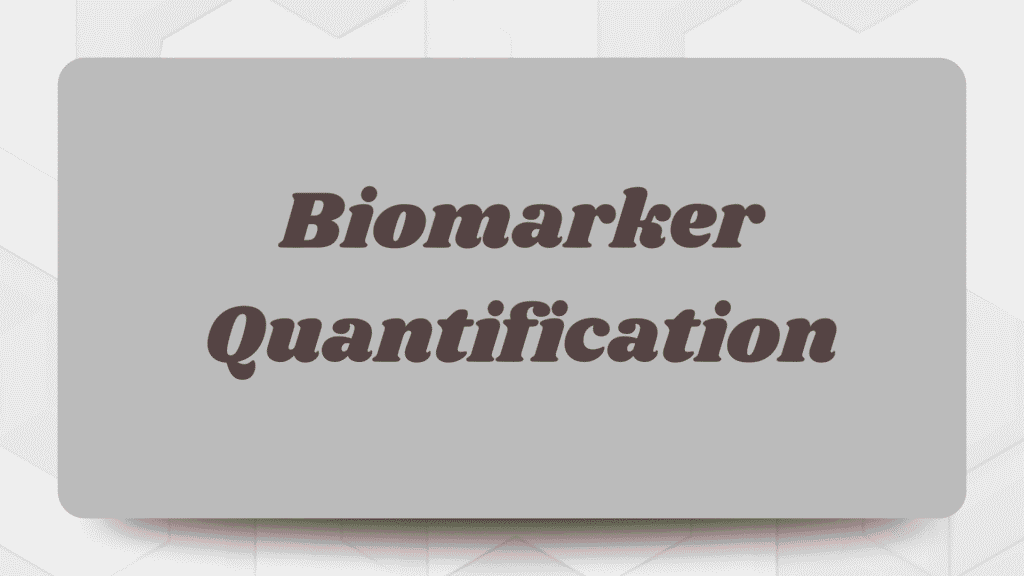Biomarker Quantification

Introduction
Biomarker quantification plays a crucial role in modern biomedical research, diagnostics, and therapeutic development. By accurately measuring biomarkers, scientists and clinicians can gain insights into disease mechanisms, monitor disease progression, and evaluate therapeutic efficacy. At Resolvemass Laboratories Inc., we offer specialized biomarker quantification services, leveraging advanced technologies to provide precise and reliable results for your research and clinical needs.
What Are Biomarkers?
Biomarkers are biological molecules that indicate the presence, progression, or severity of a disease or physiological state. They can be proteins, nucleic acids, lipids, or other molecules found in biological fluids such as blood, urine, or tissues. Biomarkers are essential for early diagnosis, personalized medicine, and monitoring the response to treatments.
Techniques for Biomarker Quantification
- Liquid Chromatography-Mass Spectrometry (LC-MS): LC-MS is a powerful technique that combines liquid chromatography for separation with mass spectrometry for detection. It is widely used for the quantification of proteins, peptides, metabolites, and other biomarkers with high sensitivity and specificity.
- Enzyme-Linked Immunosorbent Assay (ELISA): ELISA is an immunoassay method that uses specific antibodies to detect and quantify biomarkers. It is highly sensitive and commonly used for protein and peptide quantification in various biological samples.
- Quantitative PCR (qPCR): qPCR is a molecular biology technique used to quantify nucleic acids. It is employed to measure gene expression levels and quantify DNA or RNA biomarkers with high accuracy.
- Western Blotting: Western blotting is used for the detection and quantification of specific proteins in complex mixtures. It involves separation of proteins by gel electrophoresis, transfer to a membrane, and detection using specific antibodies.
- Mass Spectrometry Imaging (MSI): MSI allows for spatially resolved biomarker quantification in tissue samples. It provides detailed information on the distribution and abundance of biomarkers within tissue sections.
Applications of Biomarker Quantification
- Disease Diagnosis: Identifying and quantifying biomarkers for the early detection and diagnosis of diseases, such as cancer, cardiovascular disorders, and neurodegenerative conditions.
- Disease Monitoring: Tracking changes in biomarker levels to monitor disease progression, treatment response, and relapse.
- Drug Development: Evaluating the effects of new drugs on biomarker levels to assess therapeutic efficacy and safety.
- Personalized Medicine: Tailoring treatment strategies based on individual biomarker profiles to optimize therapeutic outcomes.
Advantages of Our Biomarker Quantification Services
- High Sensitivity and Specificity: We utilize advanced techniques to ensure accurate and reliable biomarker quantification, even at low concentrations.
- Comprehensive Solutions: Our services cover a wide range of biomarkers, including proteins, nucleic acids, and metabolites.
- Experienced Team: Our team of skilled scientists and analysts has extensive expertise in biomarker quantification and method development.
- Custom Solutions: We offer tailored biomarker quantification services to meet your specific research or clinical needs, including method development, validation, and data analysis.
Our Expertise at Resolvemass Laboratories Inc.
At Resolvemass Laboratories, we are committed to providing high-quality biomarker quantification services to support your research and clinical objectives. Our capabilities include:
- Advanced Analytical Equipment: We employ state-of-the-art LC-MS, ELISA, qPCR, and Western blotting technologies to deliver accurate and sensitive quantification.
- Method Development and Validation: We offer comprehensive support for method development and validation to ensure the reliability and reproducibility of your biomarker measurements.
- Regulatory Compliance: Our services adhere to regulatory standards and guidelines, ensuring that your data meets the necessary quality and compliance requirements.
Conclusion
Biomarker quantification is essential for advancing medical research, diagnostics, and therapeutic development. At Resolvemass Laboratories Inc., we provide expert biomarker quantification services using cutting-edge technologies and a skilled team to deliver precise and reliable results. Contact us today to learn more about how our biomarker quantification services can enhance your research and clinical efforts.
FAQs on Biomarker Quantification
Biomarker quantification is the measurement of a biological indicator (e.g. protein, nucleic acid, metabolite) in a sample, typically using analytical assays. It establishes how much of the biomarker is present, which can reflect disease state, response to therapy, or physiological processes.
Precision in biomarker quantification is critical because downstream decisions—such as patient stratification, therapeutic monitoring, or regulatory claims—depend on reliable data. Erroneous measurement can mislead clinical interpretation or drug development paths.
The LLOQ is the lowest concentration at which the biomarker can be quantified with acceptable accuracy and precision. It defines the sensitivity floor; values below this limit may be unreliable or indistinguishable from noise.
Calibration involves using standards of known concentration (often matrix-matched) to build a response curve (e.g. signal vs. concentration). Unknown sample concentrations are interpolated from this curve, assuming linearity (or suitable model) over a valid range.
Biomarkers may degrade, bind to surfaces, or be altered enzymatically if samples are mishandled. Stability studies (freeze-thaw, storage, bench time) are necessary so that quantification reflects true in vivo concentrations, not artefacts.
References
- Piorino, F., Patterson, A. T., & Styczynski, M. P. (2022). Low-cost, point-of-care biomarker quantification. Current Opinion in Biotechnology, 76, 102738. https://doi.org/10.1016/j.copbio.2022.102738
- Raunig, D., McShane, L. M., Pennello, G. A., Gatsonis, C., Carson, P. L., Voyvodic, J. T., … & Sullivan, D. C. (2014). Quantitative imaging biomarkers: A review of statistical methods for technical performance assessment. Statistical Methods in Medical Research, 24(1), 27–67. https://doi.org/10.1177/0962280214537344